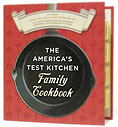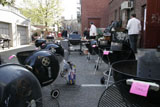- Categories:
What's Cooking at America's Test Kitchen
 Turn down Station Street, a shady side street in quaint-chic Brookline Village, Massachusetts, and you'll see a T-stop to your right, and a large brick warehouse building tucked into the block-long row of shops and businesses to your left. There, in a former mess-kit factory, is the home of America's Test Kitchen -- the place, and the people, behind the popular eponymous PBS television show and its companion cookbooks, as well as Cook's Illustrated magazine, Cook's Country magazine, and November Book Sense Pick The America's Test Kitchen Family Cookbook: Featuring More Than 1,200 Kitchen-Tested Recipes, 1,500 Photographs and No-Nonsense Equipment and Ingredient Ratings.
Turn down Station Street, a shady side street in quaint-chic Brookline Village, Massachusetts, and you'll see a T-stop to your right, and a large brick warehouse building tucked into the block-long row of shops and businesses to your left. There, in a former mess-kit factory, is the home of America's Test Kitchen -- the place, and the people, behind the popular eponymous PBS television show and its companion cookbooks, as well as Cook's Illustrated magazine, Cook's Country magazine, and November Book Sense Pick The America's Test Kitchen Family Cookbook: Featuring More Than 1,200 Kitchen-Tested Recipes, 1,500 Photographs and No-Nonsense Equipment and Ingredient Ratings.
The America's Test Kitchen (ATK) headquarters is a creative hotbed, where a talented group of people use their brains and their hands to create, and where tempting aromas perfume the air. It houses a TV studio, publishing house, and sunny, open kitchen where cooks, writers, and photographers practice their craft, and professional shoppers drop off groceries at 10:30 each morning. Editors and marketing staff have offices upstairs -- just take the spiral staircase -- as does Christopher Kimball, founder and editor of the magazines and host of the television show.
 During a recent visit to the Test Kitchen, Kimball wasn't in evidence, but the fiberglass cow -- used on the show to demonstrate various cuts of meat -- was loitering just inside the entrance to the ATK facilities, in view of the oblong wooden table where all formal tastings take place. Informal taste-testing happens in the kitchen all day long; piles of plastic spoons, plates, and napkins are set up near each cooktop for easy, sanitary access to the dishes being tested. On a given day, the lineup might include marinara sauce, cheesecake, and roasted glazed winter root vegetables. (Roasted carrots got the thumbs-up for use in an upcoming cookbook, but not the turnip -- "too bitter," said one sampler.)
During a recent visit to the Test Kitchen, Kimball wasn't in evidence, but the fiberglass cow -- used on the show to demonstrate various cuts of meat -- was loitering just inside the entrance to the ATK facilities, in view of the oblong wooden table where all formal tastings take place. Informal taste-testing happens in the kitchen all day long; piles of plastic spoons, plates, and napkins are set up near each cooktop for easy, sanitary access to the dishes being tested. On a given day, the lineup might include marinara sauce, cheesecake, and roasted glazed winter root vegetables. (Roasted carrots got the thumbs-up for use in an upcoming cookbook, but not the turnip -- "too bitter," said one sampler.)
According to Elizabeth Carduff, editor of the new cookbook and the company's editorial manager for books, it took two years to create the 864-page tome. "People are back in the kitchen now, and this cookbook is designed for people who are putting dinner on the table -- they may not want the essays [for which Cook's Illustrated magazine is known], just great cooking. We wanted to create a book that people will pass down through generations."
The book does get right to it -- page after page of recipes are accompanied by "Test Kitchen Tips," myriad color photos demonstrating various techniques, and options for home cooks who'd like "to make ahead." Descriptions and photos help readers discern the difference between a cake pan and a springform pan, select the best Parmesan cheese, or perhaps finally learn how to peel a kiwi without making a big, green mess.
Putting home cooks at ease by equipping them with the information they need to feel confident and competent was clearly a driving force behind the book. The friendly, no-nonsense ATK voice that is the hallmark of the company's television show and magazines is the foundation of the Family Cookbook, too.
But, Carduff pointed out, "This book has such different packaging from our previous books. Instead of an 800 to 1,200 word essay about how we arrived at the recipe, we tell, through the Tips, how a recipe might go wrong, or emphasize what's important -- in the America's Test Kitchen voice." And, she added, "The book has an open, simplified style."
Because it is ringbound, the book is easy to flip through, and individual pages can easily be removed and replaced (and, if you're a messy sort, you'll splatter just one page with, say, Mornay Sauce -- rather than besmirching the entire cookbook).
Readers familiar with the Best Recipes books will note the new attitude inherent in the Family Cookbook: for example, while the series books resemble Cook's Illustrated magazine -- for those unfamiliar with the publication, imagine, if you will, the New Yorker of food magazines -- the Family Cookbook's pages have less text and more graphics, from the "FAST" icon (recipes that take 30 minutes or less) to color photos of recommended products to full-page primers such as "Buying Ham 101: Sorting Out Your Best Options."
As for ATK's definition of American food, Carduff said, "We wanted to include classic American favorites -- as a company, that's what we're about. That includes international favorites that were subsumed into our culture and have become American by virtue of their popularity." Thus, macaroni and cheese, chicken soup, and apple pie are all accounted for ... as are risotto, gazpacho, and creme brulee. Paella and other international dishes, Carduff noted, "are not about being trendy, but about what readers can serve at home using ingredients they could easily find in the supermarket."
To that end, the creators of the Family Cookbook were "very careful about the ingredients list," Carduff said. The editors ensured that recommended foods and equipment are easy to find no matter where the reader lives, and ATK's professional shoppers bought only individual items, versus buying products in bulk. "We follow the home-shopper experience, so if you drain a can, we can say with certainty that it will yield a certain amount of liquid," she explained.
 The ATK cooks grill on-site, too. There's a small parking lot behind the building that morphs into barbecue central when the staff is working on grilled foods. Again, in an effort to closely replicate the home-cook experience, numerous individual grills are fired up, rather than a few gargantuan ones.
The ATK cooks grill on-site, too. There's a small parking lot behind the building that morphs into barbecue central when the staff is working on grilled foods. Again, in an effort to closely replicate the home-cook experience, numerous individual grills are fired up, rather than a few gargantuan ones.
Carduff said, "We tried to stay away from equipment the average person may not have. We make an assumption in our other books that readers cook at a certain level, that they'll have a standing mixer, for example. In this book, we include by-hand and food-processor mixing methods as well."
The book's editorial team strives to be as hands-on as possible with the cooking and recipe-testing process. The test-cooks and writers for the Family Cookbook were one and the same (as they are for America's Test Kitchen's other products). Each cook was assigned a chapter, for which they cooked and tested and cooked again. At the end of each day, the cook's-apron came off and the computer keyboard was taken up, so that the cook/writer could record her experiences, impressions, and recommendations for each recipe. (A computer program does nutritional analysis, based on information input by the cooks.)
"They are test cooks and editors," Carduff said, "and they have to be able to write and manage vast amounts of copy. When we interview cooks, they have to take a cooking and writing test -- to develop a recipe and write an essay about it. Culinary school alone is not enough ... they need experience."
Carduff is a non-cooking editor -- she and two fellow non-cook editors wrote and edited every word of the Family Cookbook once the cooks/writers had turned in their manuscripts and moved on to cook-duties for another book. "It's useful for us [as editors] to be in the kitchen," she said. "We're very connected as we go along."
And very busy -- America's Test Kitchen will be expanding its book program in keeping with its view of the Family Cookbook as a new direction for the company, and an extension of its brand: ATK publishes four to five books a year, but intends to publish 15 to 20 per year by 2008. "We want to bring America's Test Kitchen to the masses," said Carduff. --Linda M. Castellitto

